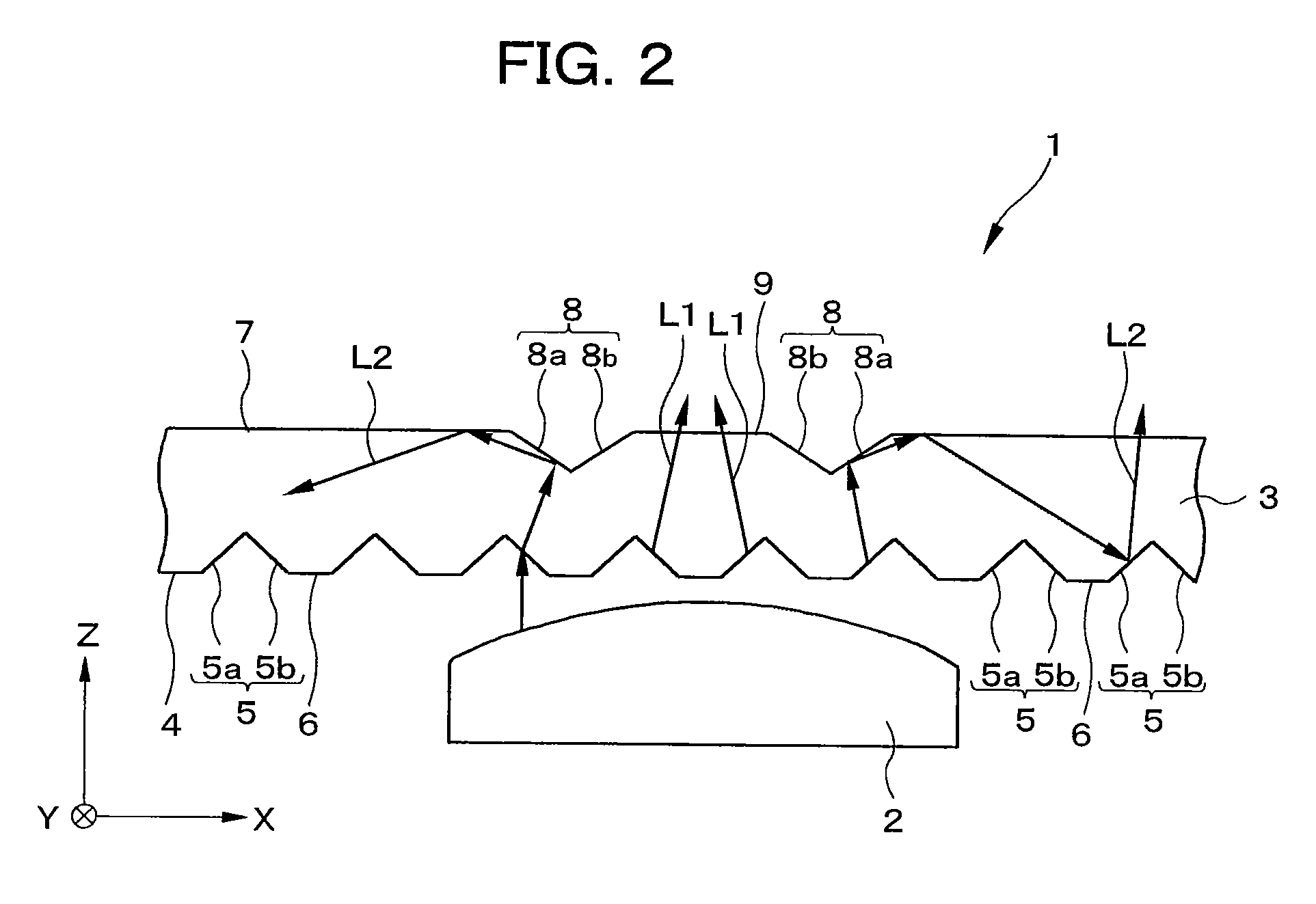Illumination device and display device
a technology of illumination device and display device, which is applied in the direction of lighting and heating apparatus, planar/plate-like light guides, instruments, etc., can solve the problems of serious problems such as small leds when compared with illumination devices, and irregular illumination intensity and brightness. achieve the effect of being inexpensiv
- Summary
- Abstract
- Description
- Claims
- Application Information
AI Technical Summary
Benefits of technology
Problems solved by technology
Method used
Image
Examples
example 1
[0131] Examples of the present invention are described below. Example 1 is first described. FIG. 25 is an optical model diagram showing an illumination device according to example 1; FIG. 26 is an enlarged view of section A in FIG. 25; FIG. 27 is an enlarged view of section B in FIG. 25; FIG. 28 is an enlarged view of section C in FIG. 25; and FIG. 29 is an enlarged view of section D in FIG. 25. The dimensions of each part are shown in FIGS. 26 through 29, and the unit of measurement is millimeter (mm).
[0132] In Example 1, nine white LEDs 52 were disposed at intervals of 9 mm, as shown in FIG. 25. The angle at which light was emitted by the white LEDs 52 was ±10 degrees, and the LEDs 52 had a disc-shaped outer contour having a diameter of 5 mm. Two light-guide plates 53a and 53b were disposed on the light-emitting side of the white LEDs 52. A reflecting plate (not shown) was additionally disposed in portions that excluded the light-emitting side of the light-guide plate 53b so as t...
example 2
[0136] An example 2 is next described. FIG. 31 is an optical model diagram of an illumination device according to example 2; FIG. 32 is an enlarged view showing section A in FIG. 31; FIG. 33 is an enlarged view showing section B in FIG. 31; FIG. 34 is an enlarged view showing section C in FIG. 31; FIG. 35 is an enlarged view showing section D in FIG. 31; FIG. 36 is an enlarged view showing section E in FIG. 31; and FIG. 37 is an enlarged view showing section F in FIG. 31. The dimensions of each part are shown in FIGS. 32 through 37, and the unit of measurement is millimeter (mm).
[0137] In example 2, nine white LEDs 62 were disposed at intervals of 8.75 mm, as shown in FIG. 35. The angle at which light was emitted by the white LEDs 62 was ±10 degrees, and the LEDs 62 had a disc-shaped outer contour having a diameter of 5 mm. Two light-guide plates 63a and 63b were disposed on the light-emitting side of the white LEDs 62. A reflecting plate (not shown) was additionally disposed in po...
example 3
[0145] An example 3 is next described. FIG. 39 is an optical model diagram showing an illumination device according to example 3; FIG. 40 is an enlarged view showing section A in FIG. 39; FIG. 41 is an enlarged view showing section B in FIG. 39; and FIG. 42 is an enlarged view showing section C in FIG. 39. The dimensions of each part are shown in FIGS. 40 through 42, and the unit of measurement is millimeter (mm).
[0146] In example 3, three each of a red LED 72R, a green LED 72G, and a blue LED (not shown), for a total of 9 LEDS, were arrayed in an order of “BGRBGRBGR,” as shown in FIG. 39. The array interval of the LEDs was 8.75 mm. The angle at which light was emitted by the LEDs 52 was ±10 degrees, and the LEDs 52 had a disc-shaped outer contour having a diameter of 5 mm. A light-guide plate 73a was disposed on the light-emitting side of the LEDs; and a light-guide plate 63b was disposed on the light-emitting side of the light-guide plate 73a. The light-guide plate 63b was the sa...
PUM
 Login to View More
Login to View More Abstract
Description
Claims
Application Information
 Login to View More
Login to View More - R&D
- Intellectual Property
- Life Sciences
- Materials
- Tech Scout
- Unparalleled Data Quality
- Higher Quality Content
- 60% Fewer Hallucinations
Browse by: Latest US Patents, China's latest patents, Technical Efficacy Thesaurus, Application Domain, Technology Topic, Popular Technical Reports.
© 2025 PatSnap. All rights reserved.Legal|Privacy policy|Modern Slavery Act Transparency Statement|Sitemap|About US| Contact US: help@patsnap.com



